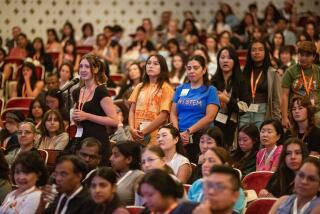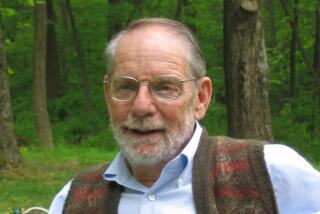Brain Scientist Gives Credit to Molder of Minds
Let’s say you’re a young brain scientist delving into the mystery of memory.
For six years, you’ve poured yourself into your doctoral dissertation. Now it’s finally done, but for one last line: The dedication is all that’s left to write in your data-laden labor of love, and you’re stumped.
You know only that it will begin with “To.”
But to whom?
Your mother? Your family? A favorite professor? To all the brave scientists who have preceded you?
It’s not a life-changing decision, but, to Allan Gulledge, it was an important one.
That’s why he dedicated his thesis--”Dopaminergic modulation of pyramidal cell excitability in rat prefrontal cortex”--to Mary Jo McPherson, who is neither a relative nor a fellow brain scientist.
Mary Jo McPherson has known Gulledge since he was just old enough to spell out R-A-T. She was his kindergarten and first-grade teacher at El Descanso School in Camarillo, and he has kept in touch with her from school to school, from lab to lab since he left her class 25 years ago.
“The thesis was the last step in my formal education, so I kind of reflected on the very beginning,” Gulledge said. “And she was there. Mrs. McPherson was a really great teacher.”
Last month, Gulledge, 31, received his doctorate from the University of Texas, San Antonio. A few weeks later, he was visiting his mother in Camarillo and took his favorite teacher out to lunch.
He handed her a copy of “Dopaminergic modulation . . .” over a basket of tortilla chips, and she told him she was very proud.
“Go ahead,” he said. “Flip through the pages . . .”
Then she saw it: “To Mary Jo McPherson, who started it all.”
He was beaming, and she was overcome.
“Oh Allan, you’re going to make me cry . . .”
Mrs. McPherson--Gulledge has always called her that--taught the early grades for 27 years before retiring in 1997. From time to time, she runs into former students, but none except Gulledge has dedicated a mountain of bioneurological research to her.
She recalls him as a bright boy who was good at math and who “just inhaled reading.” At the time he never expressed any curiosity about the prefrontal cortex.
“We were working on readin’, writin’, and ‘rithmetic,” she said, insisting she never did things much differently than other teachers.
“We made pumpkin pie from scratch, and one of the other teachers said it looked like her linoleum. We churned cream into butter. We had one day when the kids dressed up as their favorite characters. I remember Allan came with a helmet on, as Charles Lindbergh.”
Except for the fact that the class included kindergartners, first-graders and second-graders, Mrs. McPherson cast it as a standard-issue, see-Jane-run, three-plus-seven, elementary-school experience.
But that’s not how Gulledge recalls it.
“She had a really cool way of teaching,” he said. “If we were good at something, she’d let us excel at it. If we completed the first-grade math workbook, she’d open her drawer and give us the second-grade book. There were no limitations.”
As Gulledge moved on, he always came back. When a sixth-grade teacher predicted he’d be thrown out of junior high for bad handwriting and worse spelling, she reassured him. Through high school, through college, and afterward, he’d drop by her classroom every few years, just to say hi.
Last week, Gulledge flew to Australia for a postdoctoral fellowship at the John Curtin School of Medical Research in Canberra. For two years, he’ll work extensively with rats and neurons and the miracle of electronic impulses crackling through rodentine nervous systems.
As for Mrs. McPherson, she gardens, travels, plays around on the Internet and, in general, leads the pleasant-enough life of a retiree.
Of course, she drops by a classroom now and then for volunteer work. She might say it’s not exactly brain science, but others would disagree.
*
Steve Chawkins can be reached at 653-7561 or at steve.chawkins@latimes.com.






